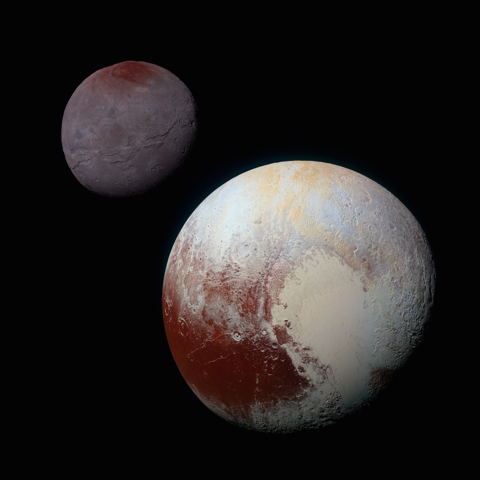Pluto’s Tilt Explains Ice Sheet’s History
In 2015, after traveling for nearly a decade, the New Horizons spacecraft sent home an image of Pluto’s icy surface that captured the hearts of Earthlings. The Valentine-worthy photo revealed a smooth, bright, two-lobed ice feature, whose western lobe is called Sputnik Planitia. This sheet of frozen nitrogen, methane, and carbon monoxide sits within a deep basin that likely originated when a large object slammed into the young dwarf planet.
But Sputnik Planitia’s formation still holds mysteries. Statistically, there’s a mere 5% chance that a 1000-km-wide impact basin formed at its current location, which is just above the equator on the side of Pluto that always faces away from its moon Charon. Perianne Johnson, a graduate student at the University of Colorado, Boulder, and her colleagues now use climate models to piece together a history of how the basin filled with ice and reoriented to its present-day geography.
A basic understanding of Sputnik Planitia was provided in 2016. Researchers proposed that a crater impact formed the basin four billion years ago; then, condensed vapors gradually filled it with mostly N2 ice. The resulting change in surface mass distribution dragged the dwarf planet’s crust into its current arrangement—changing the geographic location of the poles on the surface but without changing Pluto’s orbital axis relative to the rest of the Solar System. This surface migration effect, known as true polar wander, results from the tendency of rotating objects to reconfigure themselves so that locations with a mass excess end up at the equator, and those with a mass deficit end up at the poles.
However, Sputnik Planitia is only a few kilometers thick, making it insufficiently massive to have induced a polar-wander shift in the basin’s position from a cold crater-rich region at 60° N to its modern equatorial home. Johnson and her colleagues have now solved this ice mystery. In work presented earlier this month at the 53rd Meeting of the American Astronomical Society’s Division of Planetary Sciences, the researchers showed that climate models can track the ice levels over time and thus provide a reasonable origin of the ice sheet.
“I wanted to provide a mechanism for adding ice into the basin,” says Johnson. Her climate model determines ice deposition rates as a function of latitude. At the coldest latitudes, ice may condense naturally out of the atmosphere; at other latitudes, ice may never condense. But which latitudes are “cold” or “warm” varies with time. The dwarf planet’s tilt, or obliquity, oscillates by 25° on a 2.7-million-year cycle as a result of perturbations from other Solar System bodies. These changes strongly affect the amount of solar energy (or insolation) that strikes each part of the surface, which influences the basin’s ability to fill with ice.
Johnson’s model starts with a “snowball” Pluto, where N2 is distributed uniformly throughout the atmosphere and condenses according to climate, obliquity, and insolation variability. A basin is added to the surface at an arbitrary position (mimicking a large impact). Iterative calculations determine how much mass accumulates in the basin, how much the basin shape and surrounding area deforms, and how much Pluto’s poles wander in response to the new mass distribution. In each timestep, basin and nascent ice sheet shift to different latitudes.
By tracking the paths that a basin could follow, Johnson determined which ones led to an ice sheet whose position and thickness resemble Sputnik Planitia. The team concluded that an initial basin located at latitudes between 35° N and 50° N could have drifted south to reach its present-day location. Ice infill does not start until Pluto reaches a favorable obliquity; then, the ice sheet forms after a mere ten million years.
“Sputnik formed so quickly and likely early in Pluto’s history that we think it has been an everlasting feature on Pluto’s surface,” says Johnson. Once the basin filled with ice, obliquity cycles drove episodic sublimation and recondensation that continue to the present day. The team predicts that the ice thickness goes up and down by 10 m every 2.7 million years, which leads to periodic shifts of several kilometers in the position of the sheet.
Francis Nimmo, a planetary scientist from the University of California, Santa Cruz, says that the models describe a nice feedback loop that nobody else has captured. “They show that true polar wander can happen quickly.” He points out that the basin contains the overwhelming majority of N2 ice on Pluto. That nitrogen was likely in gaseous form early in the dwarf planet’s history. “Before Sputnik, Pluto might have had a thicker atmosphere. That’s an interesting possible consequence,” Nimmo says.
–Rachel Berkowitz
Rachel Berkowitz is a Corresponding Editor for Physics Magazine based in Vancouver, Canada.





